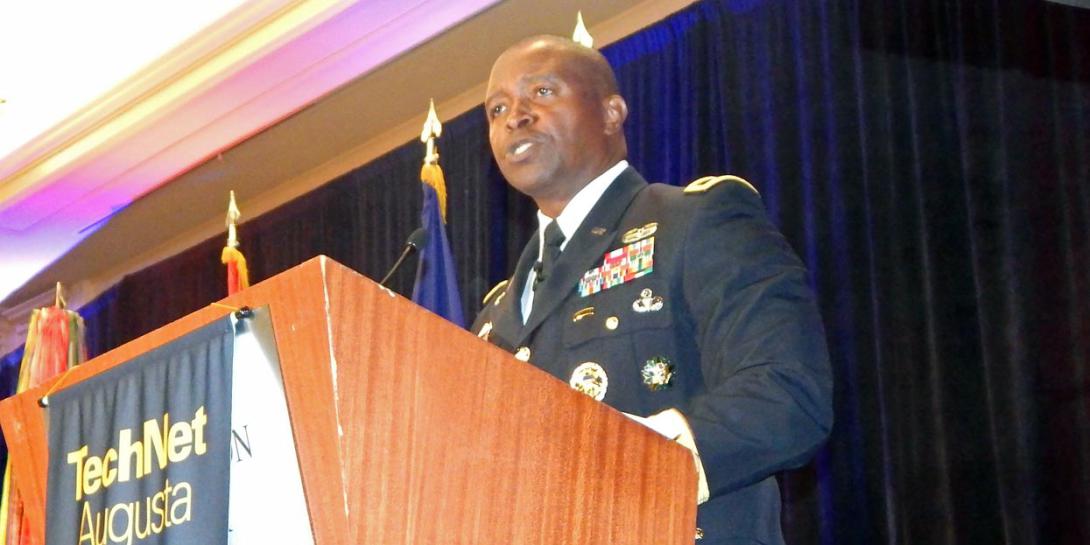Delivering the Network Warfighters Deserve
The network the Army has is not the network it needs to confront the changing face of warfare, says Maj. Gen. (P) Bruce Crawford, USA, who took over as the service’s chief information officer/G-6 nine days ago.
Gen. Crawford told the AFCEA TechNet Augusta audience the service confronts a confluence of strategic circumstances, with several major efforts all coming together at the same time. Those circumstances include the evolution of the threat, global instability that creates greater demand for ground forces, the rapid pace of technology evolution, the speed at which decisions must be made on the battlefield and emerging doctrines.
“First and foremost is the evolution of the threat capabilities, particularly an employment of fires: cyber, electronic warfare and information operations,” Gen. Crawford stated. “The bottom line when it comes to the threat is that never again will we have the luxury of operating in uncontested space.”
That realization that the future battlefield will be highly contested, he added, “has become a part of who we are now ... a part of or mindset, of our DNA.”
Gen. Crawford, @ArmyCIOG6, The best we can do is to ensure Army, as part of multi-domain battlefield, is ready and capable.#AFCEATechNet
— George Seffers (@gseffers) August 10, 2017
Regarding doctrine, the general cited the recently completed FM 3-12, which for the first time calls for integrated cyber, signal, electronic warfare and intelligence capabilities. He also mentioned FM-3-0, which offers guidance on military operations, and which the general predicted will be updated this month or next.
Because of the changing face of warfare, the Army is reviewing its network and defining what it needs for the future. The service has made strides in networking capabilities over the past 15 years or so, he offered, but it has work to do to build a network capable of coping with the confluence of strategic circumstances. “The network we have is not the network we need in a contested environment against a near-peer threat ... for the future fight,” he said. “We need a network that works for the soldier instead of making the soldier work for the network.”
Gen. Crawford, @ArmyCIOG6
— George Seffers (@gseffers) August 10, 2017
the network we have is not the network we need in the future fight against a near-peer adversary#AFCEATechNet
To meet that need, the service has defined a list of principles, warfighting requirements, characteristics and attributes, the general reported. “We’re treating the network like a weapon system where every component must function as one seamless capability to increase lethality ... on the battlefield,” he said.
Those 17 features include a network that “must enable the execution of worldwide unified land operations to shape, prevent and win as a part of unified action in all domains and in all environments,” he said, adding that the network also must enable the execution of Title X responsibilities to man, to train and to equip the force, and to build and sustain readiness preparation for war.
He described the warfighting requirements as surprisingly simple “The warfighter and the enablers—no one fights alone—must be able to shoot. They must be able to move. They must be able to communicate. They must be able to protect and sustain anywhere and anytime in all domains against any foe. It’s as simple as that,” the CIO declared.
Gen. Crawford, @ArmyCIOG6, network must be installed, operated and maintained by soldiers#AFCEATechNet
— George Seffers (@gseffers) August 10, 2017
He continued by saying the network must be not be complex. “There’s work to be done, but it’s got to be simple and intuitive, and it’s got to be installed, operated and maintained by soldiers,” he added.
The future network also must be ready, resilient, expeditionary, mobile and capable of voice, video and data on the move. “This weapon system must be standards-based. It must be protected, and it must be dynamic,” he continued. “The final attribute is that the network must enable the soldier to observe, to orient, to decide and most importantly to act. It must enable the soldier to act faster than the enemy in the conduct of unified land operations,” Gen. Crawford elaborated.
Gen. Crawford: This weapon system must be dynamic and protected, must enable the soldier to act faster than the enemy.#AFCEATechNet
— George Seffers (@gseffers) August 10, 2017
Regarding technical requirements, he said, the network will have to have continuous joint interoperability. “We’ve got a lot of things that are not seamless in terms of the ability for them to be interoperable,” he said. "In order to get the network the soldier deserves, we’re going to have to get after interoperability.”





Comments